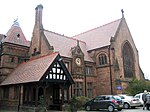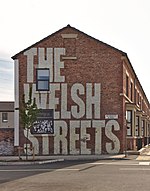Toxteth Unitarian Chapel
1618 establishments in England17th-century Protestant churchesChurches completed in 1774Churches in LiverpoolGrade I listed buildings in Liverpool ... and 3 more
Grade I listed churches in MerseysideReligious buildings and structures completed in 1618Unitarian chapels in England

Toxteth Unitarian Chapel is in Park Road, Dingle, Liverpool, Merseyside, England. Since the 1830s it has been known as The Ancient Chapel of Toxteth. It is recorded in the National Heritage List for England as a designated Grade I listed building. and continues to be in use as a Unitarian chapel. It is a member of the General Assembly of Unitarian and Free Christian Churches, the umbrella organisation for British Unitarians.
Excerpt from the Wikipedia article Toxteth Unitarian Chapel (License: CC BY-SA 3.0, Authors, Images).Toxteth Unitarian Chapel
Park Road, Liverpool Dingle
Geographical coordinates (GPS) Address External links Nearby Places Show on map
Geographical coordinates (GPS)
| Latitude | Longitude |
|---|---|
| N 53.3813 ° | E -2.958 ° |
Address
Ancient Chapel of Toxteth (Toxteth Unitarian Chapel)
Park Road
L8 9RF Liverpool, Dingle
England, United Kingdom
Open on Google Maps








